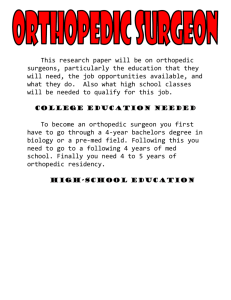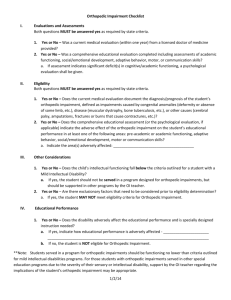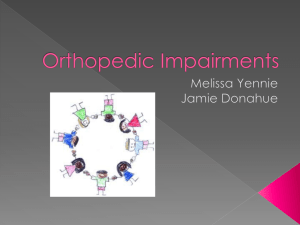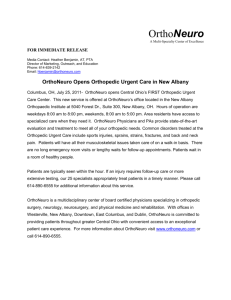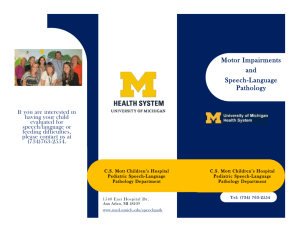Orthopedic Impairment Fact Sheet
advertisement
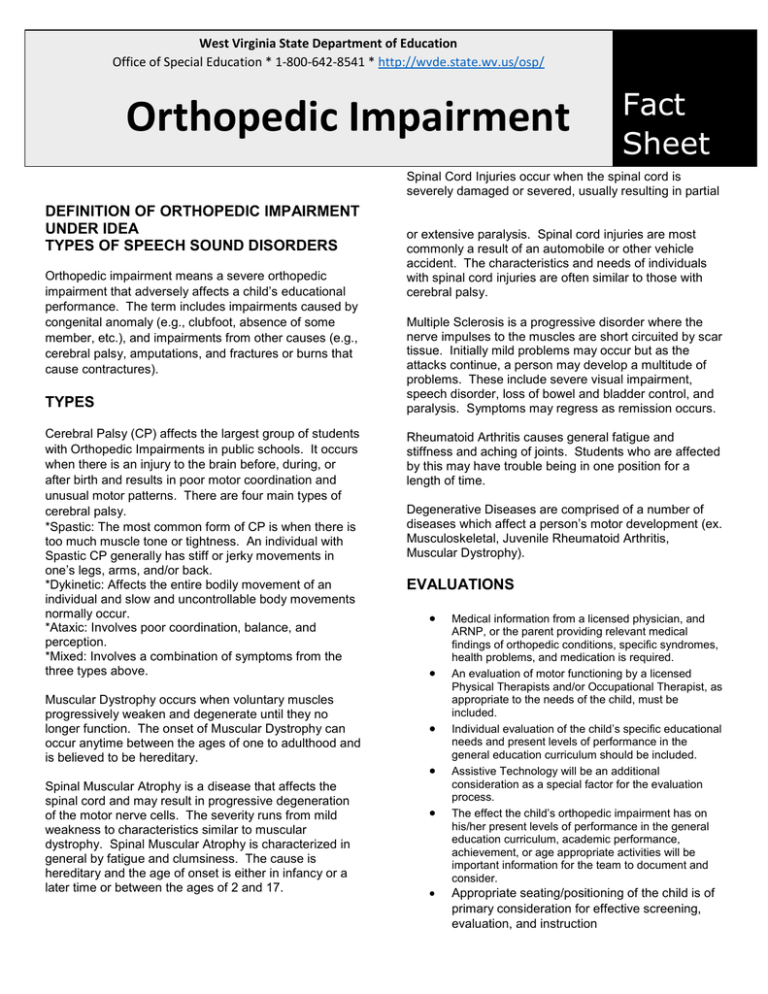
West Virginia State Department of Education Office of Special Education * 1-800-642-8541 * http://wvde.state.wv.us/osp/ Orthopedic Impairment Fact Sheet Spinal Cord Injuries occur when the spinal cord is severely damaged or severed, usually resulting in partial DEFINITION OF ORTHOPEDIC IMPAIRMENT UNDER IDEA TYPES OF SPEECH SOUND DISORDERS Orthopedic impairment means a severe orthopedic impairment that adversely affects a child’s educational performance. The term includes impairments caused by congenital anomaly (e.g., clubfoot, absence of some member, etc.), and impairments from other causes (e.g., cerebral palsy, amputations, and fractures or burns that cause contractures). TYPES Cerebral Palsy (CP) affects the largest group of students with Orthopedic Impairments in public schools. It occurs when there is an injury to the brain before, during, or after birth and results in poor motor coordination and unusual motor patterns. There are four main types of cerebral palsy. *Spastic: The most common form of CP is when there is too much muscle tone or tightness. An individual with Spastic CP generally has stiff or jerky movements in one’s legs, arms, and/or back. *Dykinetic: Affects the entire bodily movement of an individual and slow and uncontrollable body movements normally occur. *Ataxic: Involves poor coordination, balance, and perception. *Mixed: Involves a combination of symptoms from the three types above. Muscular Dystrophy occurs when voluntary muscles progressively weaken and degenerate until they no longer function. The onset of Muscular Dystrophy can occur anytime between the ages of one to adulthood and is believed to be hereditary. Spinal Muscular Atrophy is a disease that affects the spinal cord and may result in progressive degeneration of the motor nerve cells. The severity runs from mild weakness to characteristics similar to muscular dystrophy. Spinal Muscular Atrophy is characterized in general by fatigue and clumsiness. The cause is hereditary and the age of onset is either in infancy or a later time or between the ages of 2 and 17. or extensive paralysis. Spinal cord injuries are most commonly a result of an automobile or other vehicle accident. The characteristics and needs of individuals with spinal cord injuries are often similar to those with cerebral palsy. Multiple Sclerosis is a progressive disorder where the nerve impulses to the muscles are short circuited by scar tissue. Initially mild problems may occur but as the attacks continue, a person may develop a multitude of problems. These include severe visual impairment, speech disorder, loss of bowel and bladder control, and paralysis. Symptoms may regress as remission occurs. Rheumatoid Arthritis causes general fatigue and stiffness and aching of joints. Students who are affected by this may have trouble being in one position for a length of time. Degenerative Diseases are comprised of a number of diseases which affect a person’s motor development (ex. Musculoskeletal, Juvenile Rheumatoid Arthritis, Muscular Dystrophy). EVALUATIONS Medical information from a licensed physician, and ARNP, or the parent providing relevant medical findings of orthopedic conditions, specific syndromes, health problems, and medication is required. An evaluation of motor functioning by a licensed Physical Therapists and/or Occupational Therapist, as appropriate to the needs of the child, must be included. Individual evaluation of the child’s specific educational needs and present levels of performance in the general education curriculum should be included. Assistive Technology will be an additional consideration as a special factor for the evaluation process. The effect the child’s orthopedic impairment has on his/her present levels of performance in the general education curriculum, academic performance, achievement, or age appropriate activities will be important information for the team to document and consider. Appropriate seating/positioning of the child is of primary consideration for effective screening, evaluation, and instruction West Virginia State Department of Education Office of Special Education * 1-800-642-8541 * http://wvde.state.wv.us/osp/ Orthopedic Impairment Fact Sheet www.arthritis.org POSSIBLE CAUSES Being born with or acquire problems with their bones, their joints, and/or their muscles Problem stemming from deformities, diseases, injuries, or surgeries (loss of a limb, bone, or muscle tissue) Possible Signs and Characteristics. Paralysis, unsteady gait, poor muscle control, loss of a limb, etc. (causes limited mobility) Speech production and the expressive language of the child. Difficulty with large motor skills and fine motor skills Limited ability to perform daily living activities IMPACT ON LEARNING Is contingent upon the disease, its severity, and individual factors. Can be different from person to person (impact can be mild to severe). Many students with orthopedic impairments have no cognitive, learning, perceptual, language or sensory issues. Individuals with neuromotor impairments have a higher incidence of additional impairments. Some children may have significant limitations to their activity levels that require intensive medical and/or educational assistance. THIS INFORMATION DEVELOPED FROM THE FOLLOWING RESOURCES United Cerebral Palsy Associations, Inc. www.ucp.org Project Ideal http://www.projectidealonline.org/ Muscular Dystrophy Association www.mdausa.org National Dissemination Center for Children with Disabilities (NICHCY) www.mdausa.org Arthritis Foundation TEACHING TIPS/INSTRUCTIONAL STRATEGIES Always presume competence Be patient Remember that every child has different needs Collaborate with parents and other team members Use Assistive Technology CLASSROOM CONSIDERATIONS FOR STUDENTS WITH ORTHOPEDIC IMPAIRMENTS Seating arrangements to ensure the student is comfortable and able to participate. Encourage participation at all times. Instruction that is focused on development of gross and fine motor skills. Ensuring suitable augmentative communication and other assistive devices. Adequate awareness of the student’s medical condition and its effect on the student. SPECIALISTS OR RELATED SERVICE PROVIDERS THAT MAY BECOME INVOLVED IN THE STUDENT’S EDUCATIONAL TEAM: Physical Therapists (gross motor skills) Occupational Therapists (fine motor skills and daily living skills) Speech-Language Pathologists (develop communication skills) Adaptive Physical Education Teachers (exercise program development) Other Therapists (Massage Therapists, Music Therapists, etc.)
